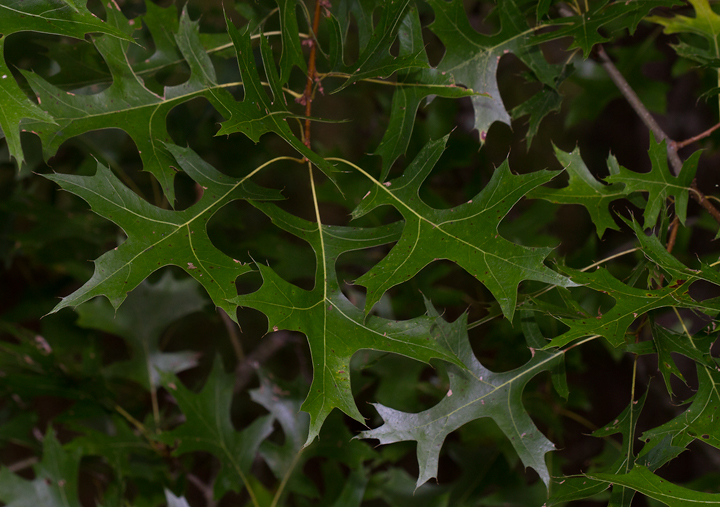Pin Oak
Quercus palustris Münchh.
Description
Pin oak is a medium-sized, deciduous oak that is a member of the beech family (Fagaceae), and typically grows up to 50-70 feet². Pin oaks are typically characterized by the growth of their branches with the bottom branches growing downwards, the middle branches being horizontal, and the top branches growing upwards7. The leaves have 5 to 9 bristle-tipped lobes with deep sinuses and are alternately arranged on the branch³. During spring, pin oaks produce small, yellow-green unisexual flowers and each tree has both male and female flowers (monoecious)². Male flowers are produced on the twigs of the previous year, while female flowers are produced on the leafy shoots of the current year. Acorns take up to two years to develop from fertilized female flowers and are about 1/3-1/2 inches long when mature³. After dropping in the fall, they germinate the following spring.

Aspect of pin oak tree with downward lower branches, horizontal middle branches and ascending upper branches. CalPoly images13

Pin oak leaves. @ B. Hubick 2012, Maryland Biodiversity Project6

Acorns of pin oak. Famartin, 2019. WikiMedia12
Distribution
Pin oak is distributed throughout parts of the eastern to central United States, ranging from Pennsylvania, Kansas, and to parts of Arkansas. Some can even be found as far north as southern Ontario, Canada4. Pin oak typically thrive in wet, acidic soils and are very commonly used in landscaping, often being planted in golf courses and on urban streets². In Maryland, pin oak trees are found statewide, occurring in all counties except Washington, Cecil, and Somerset County6.

Native distribution of pin oak. USDA11
Wildlife Importance
The acorns of pin oak trees serve as an important food source for many different animals such as deer, squirrels, and various species of birds and waterfowl¹.
Economic Importance
The wood of the pin oak tends to warp more easily than other species of oak. Because of this, the wood is commonly used and sold as fuel wood or wood pellets. Black ink can also be made from twig galls¹, which is a result of insect infestation, commonly caused by wasps10.
Threats
Chlorosis, yellowing of the leaves, often occurs when the tree is planted in more alkaline soils, which causes damage to the tree and eventually results in death if the soil chemistry is not corrected². Pin Oak trees are also susceptible to Oak Wilt, which is caused by a fungus, Ceratocystis fagacearum, that blocks off the xylem and phloem of the tree, causing an infection in the vascular system9.
Interesting Facts
- Pin oaks have a shallow, fibrous root system that lacks tap roots, making it easy to uproot and transport the tree elsewhere7.
- Some Native American tribes used to use the bark of pin oak to make a beverage to help treat intestinal pain5.
- Pin oaks are one of the fastest growing species of oak, averaging 12-15 feet in a 5-7 year period7.
References
- USDA Forest Service Fire Effects Information System: Quercus palustris
- MIssouri Botanical Garden: Quercus palustres
- Illinois Wildflowers: Pin oak
- USDA, Plant Fact Sheet, Pin Oak
- Wikipedia: Quercus palustris
- Maryland Biodiversity Project: Pin oak
- University of Kentucky College of Agriculture, Food and Environment: Pin oak
- The Morton Arboretum: Pin oak
- University of Maryland Extension: Why are oaks declining?
- University of Kentucky Entomology: Common oak galls
- USDA Forest Service Silvics Vol. 2 Hardwoods: Quercus palustris
- Wikimedia Commons: Pin oak
- Cal Poly: Pin oak
Contributed by N. Johnston
